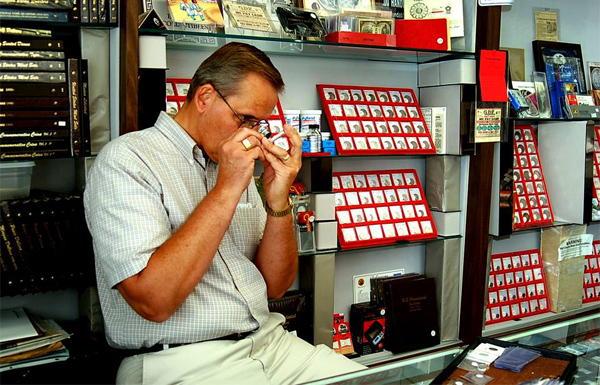What is Coin Grading?
When it comes to purchasing a product, one of the most important factors in evaluating fair price is a sure sense of a product’s condition. When buying a used car, for example, it is smart to have a trusted mechanic first check under the hood. You want to establish a proven set of criteria to be sure you are making a good investment. The same is true with coins.
Considering the many aspects that determine a coin’s value (i.e. denomination or metal content, rarity, tax-related benefits, etc…), the coin grading system has evolved over time to become a widely accepted and vital consumer protection, injecting transparency and consistency into an otherwise more subjective step in a coin’s evaluation. Today, thanks to the grading system, a collector or investor may now rely on a trusted third party to verify that a coin is authentic, unaltered, protected (so as to prevent unwanted tampering and/or damage), and most importantly, graded accurately.
At Mint State Gold we are proud to work with arguably the most well respected grading names in the business—the Professional Coin Grading System (PCGS), Numismatic Guaranty Corporation (NGC), and occasionally a few other specialized companies. We believe that our customers should feel safe knowing that his or her valuable investment-grade and rare coins are not only graded fairly, but are real.
The History of Coin Grading
The fundamentals of our modern coin grading system were first invented by Dr. William H. Sheldon in 1949 and made public through his book, Early American Cents. To help evaluate the, then larger, copper cent that was made between 1793 and 1814, he devised a 70-point scale on the principle that each rating would coincide with a multiple of the coin’s original value. For example, if a coin worth one cent was graded P1, it would still be worth one cent. If that same coin was graded VF20, it would then be worth 20 cents. Meaning also that a coin graded VF30 was worth half the price of a coin graded MS60. He then subdivided each point value into descriptive categories, which evolved into the following system:
| 1 | = | Poor | (P) |
| 2 | = | Fair | (F) |
| 3 | = | Almost Good | (AG) |
| 4 & 6 | = | Good | (G) |
| 8 & 10 | = | Very Good | (VG) |
| 12 & 15 | = | Fine | (F) |
| 20, 25, 30 & 35 | = | Very Fine | (VF) |
| 40 & 45 | = | Extremely Fine | (EF) |
| 50, 53, 55 & 58 | = | Almost Uncirculated | (AU) |
| 60 - 63 | = | Brilliant Uncirculated* | (BU) |
| 60 - 70 | = | Mint State | (MS) |
* for coins sold in rolls
Over time, the low to high point scores ceased to represent exact multiples of value and were adapted to accommodate a variety of rates. This allowed the grading system to apply to all coins.
The next major shift in the evolution of coin grading didn’t occur until 1986 when a group of dealers, led by David Hall, joined to form the Professional Coin Grading System (PCGS). As much as the coin grading system helped to bring a higher degree of order to coin buying and selling, discretion over how to use the system still fell to individual coin dealers, who graded the coins themselves. For an industry so reliant on trust, David Hall and his group recognized the need for added consumer protection.
The purpose of the PCGS was to function as an independent grading consultant. Three to five well-respected graders would each look at every coin and seal it into a plastic holder, which they labeled according to denomination, date, special attributed, and grade. The almost immediate acceptance and success of the PCGS led some of its original members to split off and form a separate grading company, the Numismatic Guaranty Corporation (NGC), founded in 1987 on the same core principles.
Today, even though more grading companies now exist, the PCGS and NGC together grade over 90 percent of the coins at market and are relied on for their time-tested expertise.
How Coins are Graded
To become an expert coin grader requires more than just having a good eye. It requires experience. The most trusted graders in the industry have honed their ability by looking at literally tens of thousands of coins of varying size, year, metal, and condition. The more coins a grader has witness firsthand, the more accurately he or she is able to evaluate subtle differences. Grading is, after all, a science of comparison.
The Four Essentials to Fair Grading
When a certified grader examines the surface of a coin there are four essential steps to the evaluation.
- The grader inspects the coin to verify that it is real. This is the most important point—to know that a coin is genuine.
- The grader verifies that the real coin has not been tampered with in any way that could artificially raise a coin’s perceived grade.
- The grader inspects the quality of the coin’s strike and die characteristics (click here to learn how coins are made) per all noted individual traits on record for that particular coin series and year. Die characteristics are recorded upon minting and catalogued. This helps the grader verify the quality of surface.
- Lastly, the grader checks the coin for various signs of use, including: obvious damage, marks, wear, loss of original luster… factors that would lead to a lower ranking on the point scale.
Upon completion of these four steps, the coin is placed safely into a protective holder and awarded a grade.
For a more detailed explanation of the Point Grading Scale, click here.







